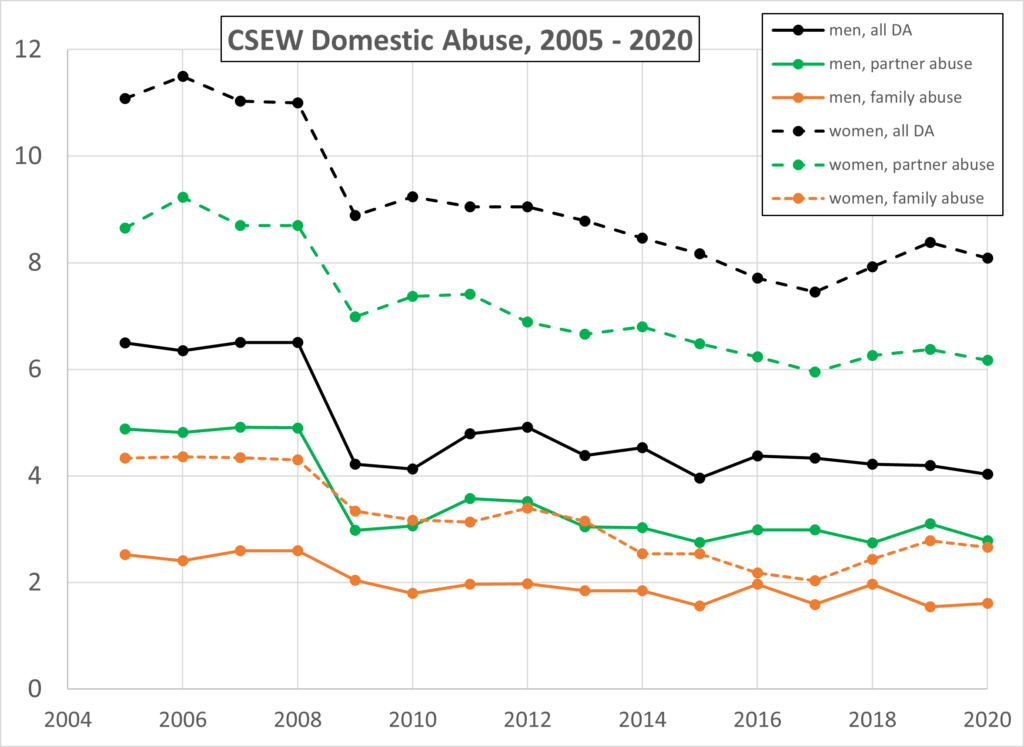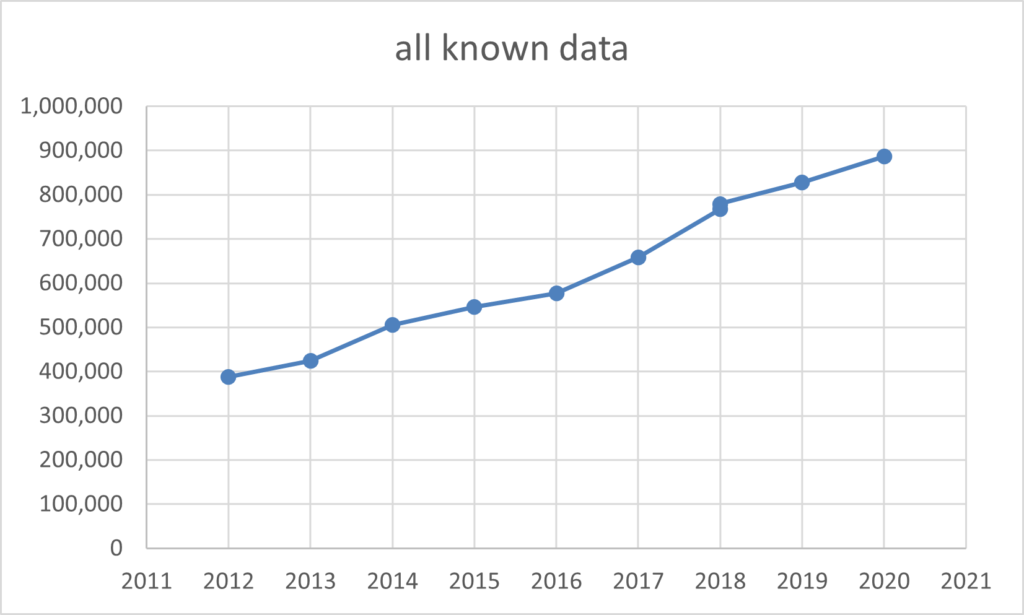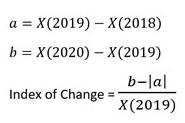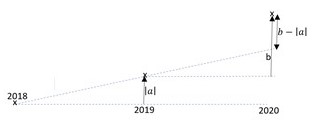23/10/21: I have updated this post following the receipt of further police forces’ FOI data.
10/11/21: Further update after obtaining one more police force’s data.
27/1/22: Final update after obtaining Northamptonshire data.
**************************
After reviewing what the narrative has been on this topic over the last 18 months, I analyse the data derived from police reports of domestic abuse across England and Wales. The latter, obtained by FOI and disaggregated by sex, tells a very different story. The impatient can skip straight to the Conclusions.
The Narrative
Not only is the Angel of Death stalking the land with unprecedented slaughter, but a by-product of Covid lockdowns has been a surge in domestic abuse – so we are told.
Before the first English lockdown started, Women’s Aid were already predicting dire consequences for victims of domestic abuse.
In August 2020 a joint Panorama/Women’s Aid “investigation” reported that domestic abuse surged in lockdown. The Guardian reported it thus, “The coronavirus crisis has dramatically compounded domestic violence against women, new research has revealed. Two-thirds of women in abusive relationships have suffered more violence from their partners during the pandemic.”
In a fine example of arguing both ways, not only lockdowns but also the ending of lockdowns have been blamed for rises in domestic abuse. In November 2020, under the title “New statistics reveal spike in domestic violence during lockdown”, Nick Thomas-Symonds for the web site Labour.org wrote,
“ONS statistics out today reveal a rise in domestic abuse related offences during the first UK national lockdown when compared to the same period in previous years. They also reveal a huge increase in numbers of calls to support services….The number of offences flagged as domestic abuse-related increased each month from April to June 2020, with the largest month-on-month increase (9%) between April and May 2020. This increase coincides with the easing of lockdown measures from 13 May 2020, when it may have been safer for victims to contact the police, painting a worrying picture for what the women’s sector have predicted will be another spike as the second bout of national lockdown measures are eased this December….Labour is calling on the Government to outline its plan to protect victims of gender-based violence and provide sustainable support for the women’s sector to help them cope with the rise in domestic abuse.”
To anyone of a vaguely empirical bent, observing a data signal that persists whether or not lockdowns are in progress might suggest that lockdowns are irrelevant to the issue – but not when one’s politically driven conclusions come first and “evidence” is the arrangement of words to suit it.
In June 2020, Human Rights Watch exposed the political motivation behind this narrative,
“The government of the United Kingdom is stalling on establishing a robust legal framework to address violence against women and girls even as reported domestic abuse spikes during the pandemic, Human Rights Watch said today. Insufficient measures to ensure critical support and services for survivors of violence – especially those least likely to get help – before and during the Covid-19 pandemic have left organizations that help some of the most vulnerable women scrambling to meet needs.
The pandemic has exposed longstanding flaws in the UK government’s approach to domestic violence,” said Hillary Margolis, senior women’s rights researcher at Human Rights Watch. “Erosion of support for specialist domestic abuse services was already a national crisis, and this is a critical moment for the government to demonstrate commitment to long-term investment in these services for every woman and girl.
The government has repeatedly said it prioritizes protection and support for women and girls experiencing violence, but it has yet to ratify a landmark European treaty on violence against women signed by the government eight years ago today. The Domestic Abuse Bill before Parliament fails to ensure protection for all women and girls.”
She refers here, of course, to ratifying the Istanbul Convention.
Not to be outdone in the representation of domestic carnage, on I February 2021, Under-Secretary of State for Justice, Alex Chalk, told us that “charities have reported a 200% increase in calls and people accessing webchat services since the first lockdown”.
On 3 February 2021, The Sun confidently informed us that, “the COVID pandemic fuelled a 10 per cent annual rise in domestic violence, it emerged yesterday as MP’s heard of a looming crisis in services for victims”.
One can hardly blame journalists for being confused about correlation versus causality when people who call themselves researchers do the same – when it suits. I have given only a small selection of the reports that abounded in news outlets over the last 18 months linking domestic abuse statistics to Covid lockdowns. None have actually established any such link, they have only asserted one.
A strong candidate for the nastiest misreporting on this issue is the article in inews on 24 September 2021 which carried this headline, “Covid-19 and domestic violence: abusive men deliberately exposed wives and partners to virus, study finds”. The article informs us that “survivors of domestic violence and abuse have been at an increased risk of contracting suspected or confirmed Covid-19, according to University of Birmingham researchers who pinned the blame on male behaviour”. I will resist the temptation to critique the study in question, but it does not say what the inews article claims.
Actually the study suggests that higher rates of Covid infection may be related to “policies to allow the free movement of DVA survivors in attempts to minimise their exposure to abusive environments” and hence that, possibly, “a clinical-safeguarding paradox may exist whereby current policy action protecting survivors from further abuse may indeed increase their risk of COVID-19”. I could take issue with this (albeit tentative) conclusion on technical grounds, but the far more significant issue is this: the study only looked at women. For all we know, an identical study and analysis conducted on men would produce similar findings. Consequently, the lurid inews headline could, for all we know, be re-written with the sexes reversed with equal veracity, or lack thereof.
Now for the cash…
In early April 2020, before the first Covid-19 peak, the Home Secretary announced £2 million to “immediately bolster” domestic abuse helplines and online support. In parallel, Priti Patel also announced the awareness campaign, #YouAreNotAlone, whose purpose was, “to reassure those affected by domestic abuse that support services remain available during this difficult time”. A male victim might ask “what support services?”.
At the start of May 2020, towards the end of the first Covid-19 wave, the Government announced a further £35M to fund domestic abuse services and safe accommodation.
In November 2020, during the second major English lockdown, the Government provided a further £10.8M to rape and domestic abuse support services.
In December 2020 the Government launched the “Ask for ANI” (Action Needed Immediately) scheme whereby people could ask for emergency assistance at their pharmacy (those which had signed-up for it), including a Safe Space arrangement in pharmacy consulting rooms.
Then on 1st February 2021 the Ministry of Justice announced a further £40M funding boost for specialist rape and domestic abuse support services. The same source gives a figure of £125M as the extra funding provided to local authorities for the provision of safe accommodation for victims of domestic abuse and their children.
That’s a grand total of an extra £213M Government funding to domestic and sexual abuse services over a 10 month period. This will be on top of the approximately £300M funding received by Women’s Aid affiliated charities in the UK annually.
The Reality
Let me say straight away that the ONS have been more measured in their reporting of the recent domestic abuse statistics than have many of those commentators who have used ONS statistics to support their pre-established political, ideological or financial interests. In a data release on 25 November 2020, “Domestic abuse during the coronavirus (COVID-19) pandemic, England and Wales”, ONS states immediately,
“Police recorded crime data show an increase in offences flagged as domestic abuse-related during the coronavirus (COVID-19) pandemic, however, there has been a gradual increase in police recorded domestic abuse-related offences over recent years as police have improved their recording of these offences; therefore it cannot be determined whether this increase can be directly attributed to the coronavirus pandemic.”
Finally! Someone states the bleedin’ obvious. You cannot conclude anything about lockdowns from a greater level of police reports of DV in 2020 compared to 2019.
A greater prevalence of reports of DV in 2020 compared to 2019 was expected anyway, irrespective of Covid, because the volume of DV reports to the police has been increasing for ten years (at least). This is unlikely to be because of an increase in the number of victims of DV because the CSEWs have been showing either a decreasing prevalence of DV by victim, or a roughly flat prevalence trend, over the same period (see The Empathy Gap Figure 9.9 and Figure 1 below). An increasing number of incidents per victim may be part of the explanation for the increasing police record data, though an increasing propensity to call the police together with better police record keeping will also be part of the explanation.

I have obtained data on the numbers of reports of domestic abuse recorded by police in the last three complete calendar years via Freedom Of Information enquiry. The following words were used, raising an FOI on each of the 42 police forces in England and Wales,
“Please provide the total number of reports recorded by you and categorised as domestic abuse or domestic violence in each of the last three calendar years (2018, 2019, and 2020), disaggregated by sex of complainant or victim. “
I currently have responses from 38 police forces (one with incomplete 2018 data) and have decided to analyse at this point. I will update this post if I obtain further data from the remaining 4 forces (two have refused on the grounds of time/cost).
These data, for 2018, 2019 and 2020, can be augmented by the comparable data for years 2012 to 2018 reported by Mankind Initiative.
I shall address two objectives,
- Demonstrate that police reports of DA have been trending up for a decade across virtually all police regions, and,
- Analyse whether the volume of reports in 2020 was or was not larger than expected based on the trends.
For the first of these I use my own FOI data for 2018, 2019 and 2020, covering 38 police forces, plus the Mankind Initiative data for all 42 forces between 2012 and 2018. I have performed a simple linear regression against year of the total recorded crime incidents categorised as DV. 38 of the 42 police forces data have positive regression coefficients (slopes), indicative of a trend of increasing numbers of DV reports to each of these 38 forces over the period 2012 to 2020. Of the 4 forces which have a negative regression coefficient (trend of decreasing reports), three are not statistically significant (p > 0.05). Of the 38 forces with positive regression coefficients (increasing trend), the coefficient is significant at the 95% confidence level in 25 cases. In 16 of these cases significance is at the 99.9% confidence level.

Summing all DV incidents over England and Wales shows a positive upward trend significant at the one-in-ten-million level. The corresponding graph is shown as Figure 2.
This establishes that police recorded DV-related incidents have been trending upwards over the last decade, and hence that a larger number of such reports in 2020 compared to 2019 means nothing as regards the effect, or otherwise, of Covid lockdowns.
To address my second objective I need to establish a means of detecting whether the number of police reports in 2020 was in excess of what might have been expected based on a continuing upward trend. In fact, Figure 2 almost clinches the issue already as there is no sudden ‘blip’ in 2020, rather the 2020 data continues the previous trend, the slope of the data between 2018 and 2020 being broadly similar to that earlier.
However, to address this question with greater precision, I shall examine individually all 38 forces’ for which I have complete data. To do so I define an Index of Change as follows. Represent by X any of the following quantities: (i) number of male victims (m), (ii) number of female victims (f), (iii) the total number of victims (including those for whom sex was not ascertained), or, (iv) the ratio of male to total victims of known sex, m/(m+f).
The meaning of the quantities involved is illustrated by Figures 3a and 3b,
The Index of Change is positive if the value of X(2020) exceeds what would have been expected based on the trend between 2018 and 2019. Conversely, the Index of Change is negative if the value of X(2020) is less than what would have been expected based on the trend between 2018 and 2019. The magnitude of the Index of Change is the extent of the deviation from expectation expressed as a fraction of X(2019). (Multiplying by 100 gives the Index of Change as a percentage).
Table 1 shows how many of the individual police forces produce negative or positive Indices of Change for each of the four interpretations of the variable X. When this is the number of male victims, the number of female victims or the total number of victims, there are more negative than positive Indices, indicating that the number of police forces which reported smaller numbers of victims than expected based on the 2018 to 2019 trend exceeds the number of forces which reported larger numbers of victims than expected.
| X | Number of forces with negative IOC | Number of forces with positive IOC | IOC for whole of England and Wales (38 Forces) |
| Female victims | 25 | 13 | -2.9% |
| Male victims | 23 | 15 | 2.4% |
| Total victims | 26 | 13 | 1.3% |
| Percentage of victims who are male | 16 | 22 | 3.3% |
In contrast, when X is the number of male victims expressed as a percentage of all victims of known sex, m/(m+f), the Index of Change is positive for more forces than it is negative, i.e., the number of police forces which reported a larger victim sex ratio than expected based on the 2018 to 2019 trend exceeds the number of forces which reported a smaller sex ratio than expected.
Figure 4 gives the histogram of Indices of Change for the 32 police forces. The three points with the largest Indices relate to the West Midlands (women 22%, men 33%, total 15%). This is not the first time that the West Midlands has stood out in a matter related to domestic abuse. I (and others) have previously shown that the West Midlands exhibited by far the largest increase in Non-Molestation Orders after LASPO (see Legal Aid and Domestic Violence in the Family Courts, Table 2).

The last column of Table 1 is based on the total number of victims summed over the 36 police forces who responded to my FOI (or, in the case of the percentage of male victims, the average of this percentage over the 36 forces). The overall Index of Change is negative for female victims, but positive for male victims, total victims and the percentage of male victims.
Finally, the percentage of police reports of DV which relate to male victims continues to trend upwards, as it has for years – Figure 5.
Conclusions
- The police recorded data on numbers of reported incidents classified as DV have been trending up across almost all police forces for at least a decade.
- This contrasts with CSEW data on numbers of DV victims which has not been trending up, but either trending down or roughly static.
- A larger number of police recorded DV incidents in 2020 compared with 2019 cannot be taken as indicative of a Covid lockdown effect as it was expected, without Covid, based on current trends.
- Instead the issue of whether 2020 brought an unexpectedly large volume of DV incidents must be explored by measuring any exceedance of reported incidents from that expected based on trends. This measure is provided here by the defined Index of Change.
- More police forces reported data which indicated that the volume of incidents in 2020 was less than expected based on trends than the number of forces reporting greater volumes than expected. This suggests there was no significant “Covid lockdown” enhancement of DV prevalence in 2020 across England and Wales as a whole.
- Based on summing incidents across the 38 police forces responding to my FOI, the overall Index of Change for women victims was negative (-2.9%) whilst for male victims it was positive (+2.4%). These are only small deviations from expectation, but if there is a “Covid lockdown” enhancement of DV across England and Wales as a whole it applies only to male victims.
- Some police force areas do have positive Index of Change, indicating possible local lockdown effects (though I have no evidence that lockdowns are the cause of any enhancement). Of these the West Midlands is by far the most significant, with a 33% excess of incidents involving male victims and an excess of 22% for female victims.



